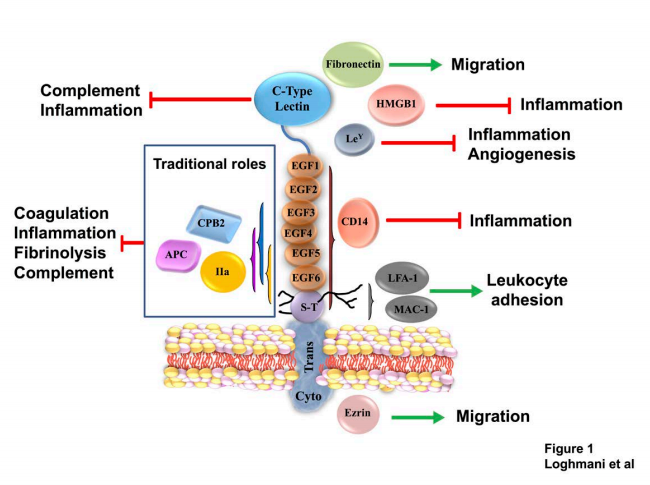By Wayne Zhao, PhD Student, Devine Lab 
As its name suggests, thrombomodulin (TM) modulates thrombin activity. The traditional role of TM is to vastly accelerate production of activated protein C from its zymogen by thrombin. This discovery, made in the 1980s, has established TM as an integral part of the anticoagulant protein C system. Given its wide expression in multiple cell types in humans, in addition to endothelial cells lining blood vessels, scientists have discovered that TM is also involved in non-traditional processes beyond the hemostatic system. In their review paper “Exploring traditional and non-traditional roles for thrombomodulin”, Drs. Conway and Loghmani summarize the known functions of TM and introduce new pathways and mechanisms that TM has recently found to be involved in.
TM is a complex transmembrane glycoprotein with five distinct structural regions (Figure 1). Several regions have been linked to mechanisms in the body other than hemostasis. For example, the lectin-like domain of TM exhibits anti-inflammatory and cytoprotective functions in a murine model of reoxygenation injury and inflammation. One possible pathway to achieve these effects is through sequestering HMGB1, which prevents it from engaging TLR4 and triggering reactive oxygen species production and NFκB signalling. However, TM has also been found to exhibit pro-inflammatory effects. In this case, monocytes expressing TM can trigger firm monocyte-endothelial interaction thereby increasing macrophage infiltration after injury. These opposite effects are both seemingly orchestrated by the lectin-like domain of TM. The exact mechanism by which a single domain is able to achieve different immune effects is not clear and needs to be investigated.

Figure 1. Thrombomodulin’s five distinct structural regions have been linked to mechanisms in the body other than hemostasis.
Given its involvement in multiple biological pathways, TM is being actively studied in the context of disease. It is becoming clear that both the traditional and non-traditional roles of TM have profound effects on the progression and pathogenesis of a wide variety of diseases. These studies, however, also further exemplify the complexity of TM and how more research is needed to fully understand its functions. For example, in diabetic nephropathy, TM has been found to have a protective effect. Specifically, diabetic mice which receive recombinant lectin-like domain of TM have less nephropathy and fibrotic damage. There are also fewer macrophages observed in their kidneys which suggest less harmful inflammation. In contrast, in atherosclerosis, TM has been proposed to exacerbate vascular damage by promoting monocyte adhesion to endothelium. It is not yet clear how TM can have anti-inflammatory effects in one disease but pro-inflammatory in the other.
Drs. Conway and Loghmani have written this review to illustrate the diverse functions of TM. They also come to the conclusion that more research is needed to address the gaps in the understanding of this integral membrane protein. It is their hope that through research, one day we will be able to target or modify TM to treat a variety of diseases leading to improved health of patients.
- Loghmani H. & Conway E.M. Exploring traditional and non-traditional roles for thrombomodulin. Blood 132, 148-158 (2018).


